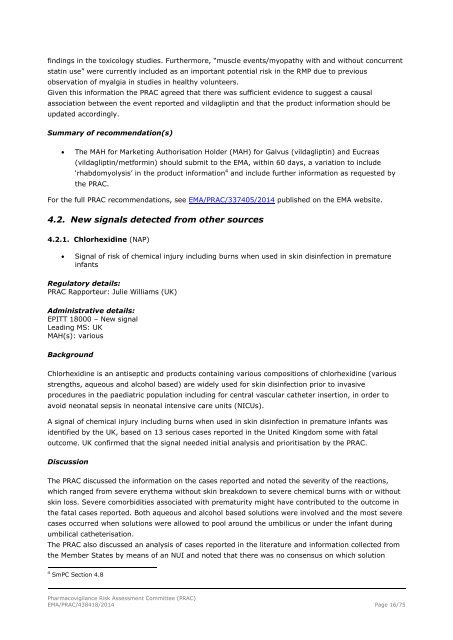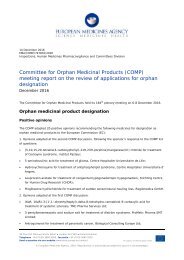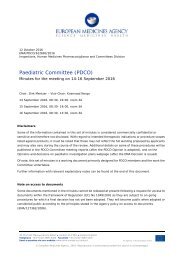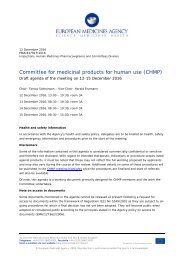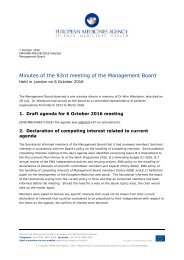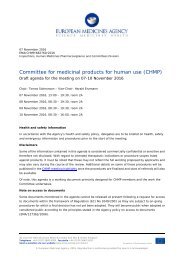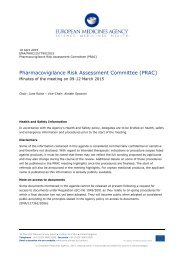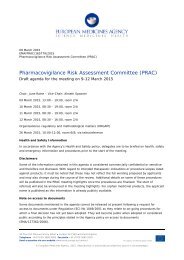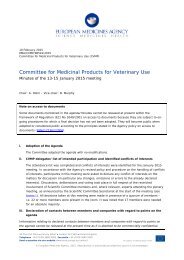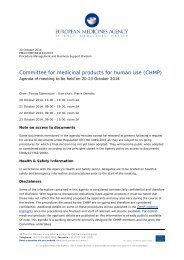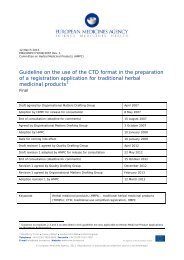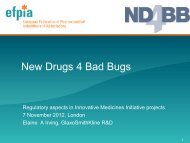1u7kf0g
1u7kf0g
1u7kf0g
Create successful ePaper yourself
Turn your PDF publications into a flip-book with our unique Google optimized e-Paper software.
findings in the toxicology studies. Furthermore, “muscle events/myopathy with and without concurrent<br />
statin use” were currently included as an important potential risk in the RMP due to previous<br />
observation of myalgia in studies in healthy volunteers.<br />
Given this information the PRAC agreed that there was sufficient evidence to suggest a causal<br />
association between the event reported and vildagliptin and that the product information should be<br />
updated accordingly.<br />
Summary of recommendation(s)<br />
<br />
The MAH for Marketing Authorisation Holder (MAH) for Galvus (vildagliptin) and Eucreas<br />
(vildagliptin/metformin) should submit to the EMA, within 60 days, a variation to include<br />
‘rhabdomyolysis’ in the product information 4 and include further information as requested by<br />
the PRAC.<br />
For the full PRAC recommendations, see EMA/PRAC/337405/2014 published on the EMA website.<br />
4.2. New signals detected from other sources<br />
4.2.1. Chlorhexidine (NAP)<br />
<br />
Signal of risk of chemical injury including burns when used in skin disinfection in premature<br />
infants<br />
Regulatory details:<br />
PRAC Rapporteur: Julie Williams (UK)<br />
Administrative details:<br />
EPITT 18000 – New signal<br />
Leading MS: UK<br />
MAH(s): various<br />
Background<br />
Chlorhexidine is an antiseptic and products containing various compositions of chlorhexidine (various<br />
strengths, aqueous and alcohol based) are widely used for skin disinfection prior to invasive<br />
procedures in the paediatric population including for central vascular catheter insertion, in order to<br />
avoid neonatal sepsis in neonatal intensive care units (NICUs).<br />
A signal of chemical injury including burns when used in skin disinfection in premature infants was<br />
identified by the UK, based on 13 serious cases reported in the United Kingdom some with fatal<br />
outcome. UK confirmed that the signal needed initial analysis and prioritisation by the PRAC.<br />
Discussion<br />
The PRAC discussed the information on the cases reported and noted the severity of the reactions,<br />
which ranged from severe erythema without skin breakdown to severe chemical burns with or without<br />
skin loss. Severe comorbidities associated with prematurity might have contributed to the outcome in<br />
the fatal cases reported. Both aqueous and alcohol based solutions were involved and the most severe<br />
cases occurred when solutions were allowed to pool around the umbilicus or under the infant during<br />
umbilical catheterisation.<br />
The PRAC also discussed an analysis of cases reported in the literature and information collected from<br />
the Member States by means of an NUI and noted that there was no consensus on which solution<br />
4 SmPC Section 4.8<br />
Pharmacovigilance Risk Assessment Committee (PRAC)<br />
EMA/PRAC/438418/2014 Page 16/75


